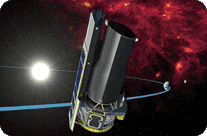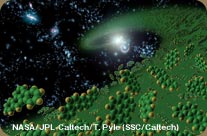|
 |
 |
 |
 |
 |
|



I'm quite delighted and impressed to see the level of sophistication of astronomers in Japan. In particular, for such a small community, our colleagues are having a major impact and are very visible on the international scene, especially with these payloads going to space. I think this is a very demanding pursuit, and I'm delighted to see that they are making progress and having these successes. And I wish them every success, especially for the Akari (ASTRO-F) launch.
 |
|
|


With complementary functions, Akari and SST, the Spitzer Space Telescope, are like brothers in orbit. One simple example is that Akari is designed to survey the whole sky, while Spitzer is not. Even if it were dedicated completely to surveying the sky, it would still only cover just a small percentage of the sky over its lifetime. That's one important distinction. And Akari is also carrying instrumentation that does not have equivalents on Spitzer, such as the long wavelength spectrometers.
What I am hoping will happen is that, with the All-Sky Survey Akari will conduct, as you start finding new types of astronomical objects, or very interesting, unusual objects, you will be able to propose for Spitzer to do follow-up where it may have capabilities that are not on Akari. Similarly if we find interesting objects with Spitzer that would benefit from more in-depth study with Akari, we would find a way to make these collaborative studies work.
Unfortunately, I have been too busy with Spitzer to engage in any meaningful collaboration on Akari. I would welcome the opportunity of collaborating with my colleagues in Japan, as we have done in the past. There are several areas of interest where I think the synergy between Spitzer and Akari would be very beneficial.
|
|


Spitzer Space Telescope (SST) |
|
|


To my mind, one of the greatest discoveries that Spitzer has made outside of my area of specialty is the direct detection of planets around other stars. This is something we never thought Spitzer would be able to do, but in fact we are able to detect light coming from planets that are orbiting around stars that are in one case 150 light years away and in another case 500 light years away from us. They are about the size of Jupiter or a little bit smaller, and they are warmer than Jupiter. This opens the door to us being able to study directly the nature of planets around other stars. And I'm sure we'll do a lot more measurements of this kind during the lifetime of Spitzer, and will be able for the first time to study the properties of these planets directly.
In my field of research, another significant discovery is the detection of polycyclic aromatic hydrocarbons in galaxies at very great distances. They are compounds that are related to biological processes, and they are very common in the local universe. This is the first time we've been able to detect them very early in the life of galaxies. This indicates that by the time we see these galaxies, several generations of stars have already been formed.
|
|


An extrasolar planet was directly detected by SST (artist's conception)

The discovery of polycyclic aromatic hydrocarbons, compounds related to biological processes (artist's conception) |
|

 |
|



